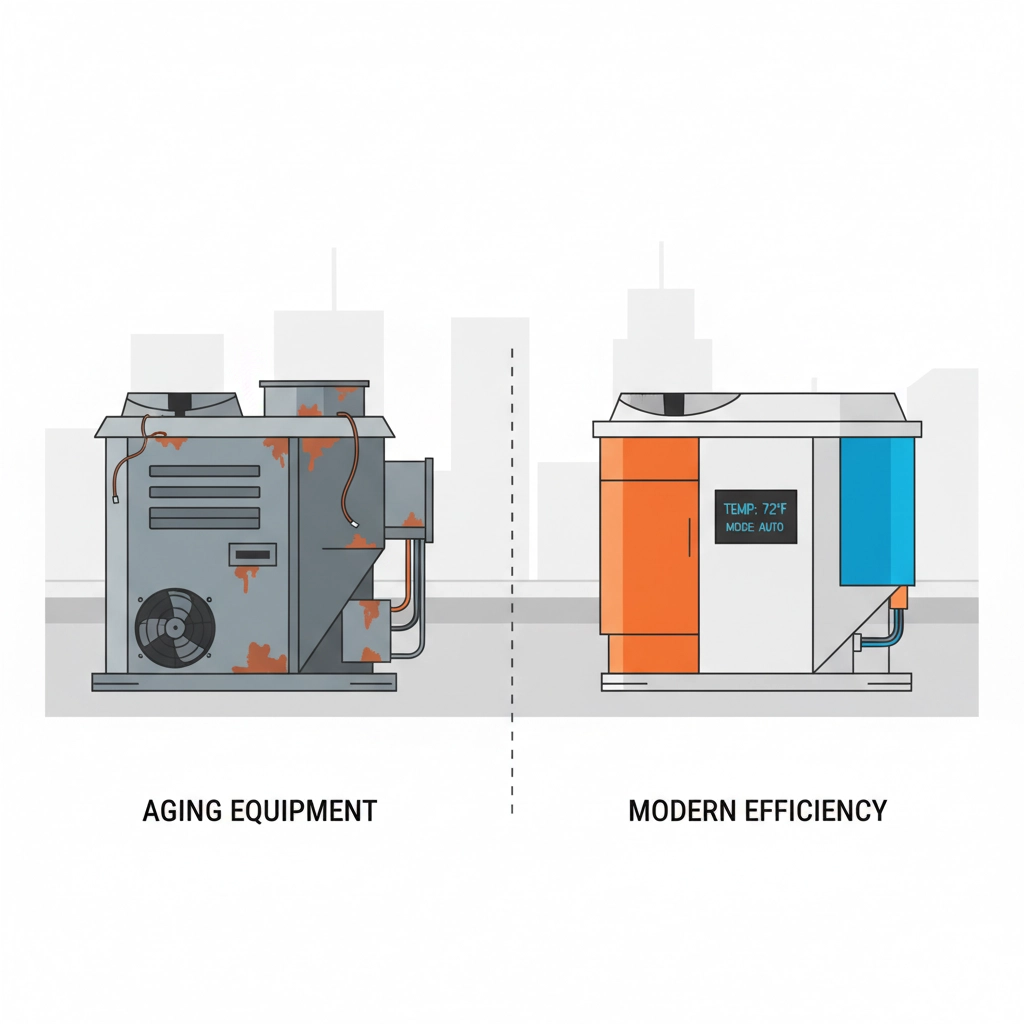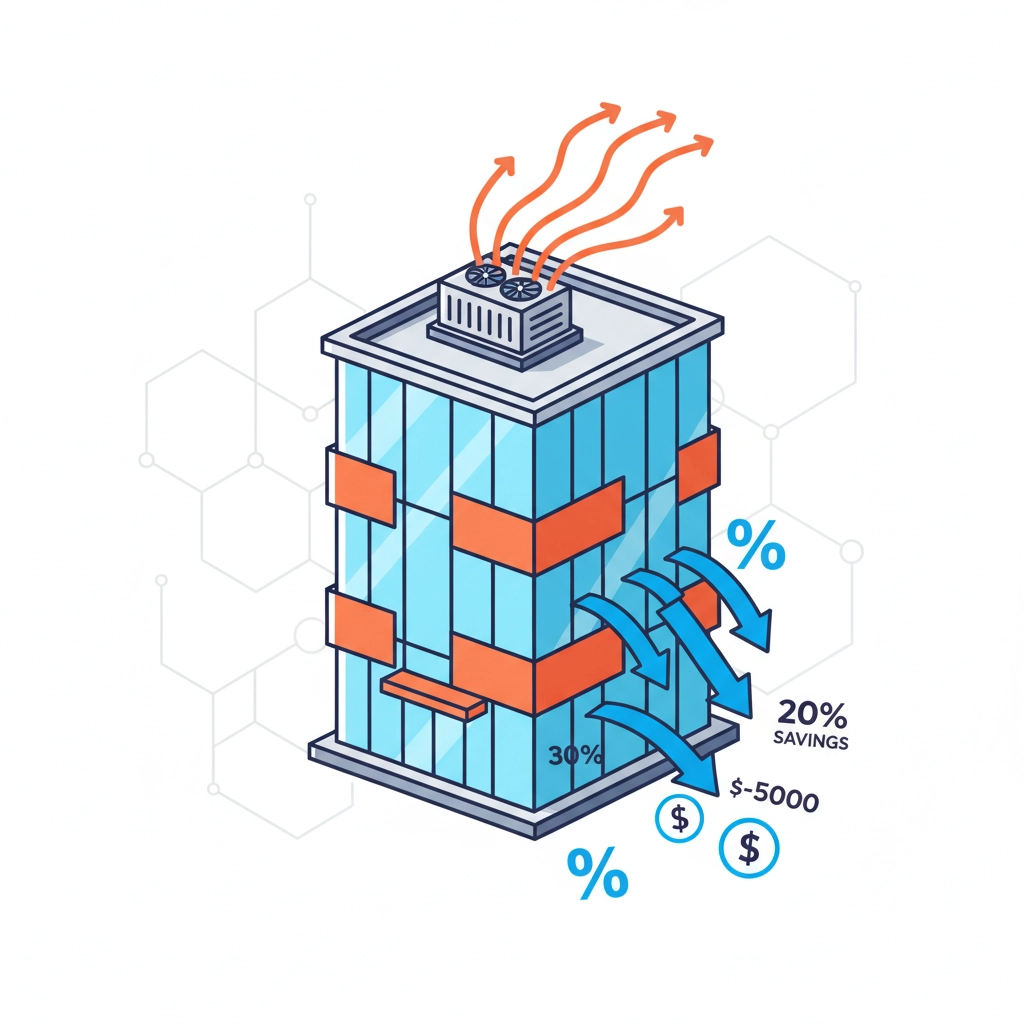Heat Pump Myths for Commercial Spaces — What’s Actually True in South Jersey
Commercial Heat Pump Myths: What’s Actually True in South Jersey
Thinking about heat pumps for your office, school, or storefront in Southern NJ? You’ve probably heard a lot of opinions. Some are true. Many are not. This guide clears up the biggest commercial heat pump myths and explains how smart commercial preventative maintenance keeps your system reliable when South Jersey weather swings from humid August afternoons to icy January mornings.
If you want a quick primer before we dive in, see how we approach commercial heat pump myths in Southern NJ from a whole-building perspective at {{ company-name }}. We design, maintain, and help manage systems so you spend less time worrying about comfort and more time running your business.
Cold-Weather Performance And COP Explained
COP stands for coefficient of performance. It compares how much heat a system delivers to how much electricity it uses. A COP of 3 means the heat pump provides three units of heat for every unit of electricity. As outdoor temperatures drop, a heat pump works harder and COP usually falls. That’s normal.
Modern commercial systems use variable-speed compressors, intelligent defrost, and cold-climate designs that hold steady output in typical South Jersey winter conditions. The real key is proper sizing, controls, and regular tune-ups so your equipment stays in its most efficient operating range.
Myth 1: “Heat Pumps Don’t Work In South Jersey Winters”
South Jersey winters can be messy. Think nor’easters, bay winds, and overnight freezes in Toms River, Cherry Hill, Mount Laurel, and Atlantic City. The myth says heat pumps can’t keep up. The truth is that cold-climate commercial units are built for exactly this challenge. With smart staging, demand defrost, and the right airflow, they heat predictably through most cold snaps we see here.
What matters most is design. Loads change across open offices, stairwells, server rooms, and glassy lobbies. Good design puts capacity where you need it, not just on paper. That’s why we start with a building-by-building plan and verify it in the field during seasonal maintenance.

Myth 2: “You Always Need Expensive Backup Heat”
Backup heat is a tool, not a rule. In many Southern NJ buildings, a well-chosen heat pump handles the bulk of winter. Backup options like staged electric elements or dual-fuel switchover cover the rare hours when the cold is most severe or when a specific zone needs a quick bump. Balanced right, backup heat hardly runs.
We set the switchover temperature based on your comfort, utility rates, and hours of operation. In mixed-use buildings, we may set different strategies for offices, production floors, and lobbies. The goal is comfort with predictable bills, not an oversized backup system you rarely use.
Myth 3: “Heat Pumps Only Work In New Buildings”
Not true. We retrofit heat pumps into older brick offices, retail strips, and schools across Southern NJ. Options include rooftop units, VRF/VRV systems, and water-source heat pumps tied to existing loops. Most projects focus on smart phasing so you can stay open while work happens zone by zone.
Controls upgrades often make the biggest difference. Schedules, setbacks, and ventilation strategies tuned to your actual occupancy unlock savings without sacrificing comfort. Pair that with routine commercial preventative maintenance and you get reliable performance long after the ribbon cutting.
Myth 4: “Heat Pumps Are Loud And Disruptive”
Early models were louder. Today’s commercial systems use variable-speed fans, inverter technology, and better vibration isolation. Sound is measured and managed like any other design factor. Good placement, line set routing, and proper mounting deliver quiet operation your team barely notices.
In offices and classrooms, steady low-speed operation actually reduces noise compared with systems that cycle hard on and off. That creates fewer hot-cold swings and a calmer workspace.
Myth 5: “Heat Pumps Can’t Handle Humidity In Busy Spaces”
South Jersey summers are humid. Modern heat pumps are excellent at dehumidification because variable-speed operation lets them run longer at lower power, which pulls more moisture from the air. In high-traffic buildings, we can fine-tune fan speeds, coil temps, and reheat strategies through the controls to keep indoor humidity in a healthy range.
When events or occupancy spike, the system can shift to prioritize humidity control over rapid temperature changes. That protects comfort and helps avoid condensation issues on glass or ductwork.

The Real Keys: Design, Controls, And Maintenance
Most “myths” are really design or maintenance misses. A high-performance heat pump needs correct airflow, refrigerant charge, and controls that match your schedule. That’s why our team focuses on the full life cycle, not just the install. Seasonal tune-ups find issues early and keep you at target COP through the year.
For ongoing peace of mind, many South Jersey facility managers rely on our commercial maintenance agreements. Priority response, documented inspections, and scheduled tune-ups make performance more predictable and budgeting simpler.
What We Check During Seasonal Visits
Every building is different, but a consistent maintenance process reduces surprises. Here’s a sample of what our commercial techs evaluate across offices, retail spaces, and campuses:
- Airflow and static pressure to confirm comfort in corner offices, open floors, and conference rooms
- Refrigerant operating conditions and defrost performance for steady winter heat
- Sensor calibration and control sequences so schedules match real occupancy
- Drainage, coils, and cleanliness that affect both efficiency and indoor air quality
- Electrical connections, contactors, and safeties to reduce downtime risk
To see how maintenance impacts energy use and uptime, take a look at our article on why commercial HVAC maintenance matters. It shows how routine service avoids many of the “myths” people blame on the equipment.
Myth 6: “Heat Pumps Can’t Compete With Gas Heat For Comfort”
Comfort is about even temperatures and good air mixing. Heat pumps excel here because they modulate. Instead of blasting hot air and shutting off, they hold a steady setpoint. That means fewer drafts and fewer complaints.
In buildings with high infiltration or older windows, we may use a hybrid approach, adding targeted backup heat only for the coldest hours. The result feels the same to occupants, with smoother temperatures and lower energy use most of the season.
Myth 7: “All Heat Pumps Are The Same”
They aren’t. A small retail shop in Atlantic City needs a different setup than a medical office in Toms River. Rooftop units, split systems, VRF, and water-source heat pumps each have strengths. Choosing the right one and pairing it with the right controls delivers better comfort and fewer service calls.
It’s also important to align the equipment with your electric service and rate structure. Demand charges, operating hours, and ventilation needs all affect what “best” looks like for your property.
How Preventative Maintenance Protects Heat Pump ROI
Heat pumps are efficient by design, but efficiency can slip without care. Dirt on coils, poor airflow, or a drifting sensor all chip away at COP. Steady attention gives that performance back. Over a year, those small wins stack up in lower bills, fewer repairs, and better comfort.
- Plan around seasons. Cooling tune-ups in spring and heating tune-ups in fall help you avoid peak-season surprises.
- Confirm what the data says. Controls reports and trend logs make problems visible before occupants notice them.
Want a practical game plan for your building? Our overview on maximizing HVAC efficiency shows how scheduling, zoning, and maintenance work together to keep costs predictable.
What This Means For Your Building In Southern NJ
Heat pumps can effectively heat and cool most South Jersey commercial spaces, providing comfortable and efficient heating and cooling solutions. The difference between myth and reality comes down to planning and care. When your system is sized, installed, and maintained correctly, winter performance is steady, summer humidity is under control, and occupant complaints decrease.
If you manage facilities across Toms River, Cherry Hill, or along the Shore, it pays to standardize your approach. Align setpoints, schedules, and maintenance across sites so each building runs like your best one. That’s where {{ company-name }} can help, from design to seasonal service.
Ready To Separate Fact From Fiction?
Heat pumps are a strong choice for buildings in South Jersey. For reliable comfort and predictable energy use, start with a seasonal plan. Our team at {{ company-name }} is ready to tailor a program to your hours, occupancy, and goals. To get started, call {{ phone-number which=’1′ }} or talk with us about a plan that fits your schedule.
When you’re ready to turn today’s insight into action, schedule your next visit through our page on commercial preventative maintenance in South Jersey. The sooner we baseline your system, the sooner you get the steady comfort and savings you’ve been promised.








